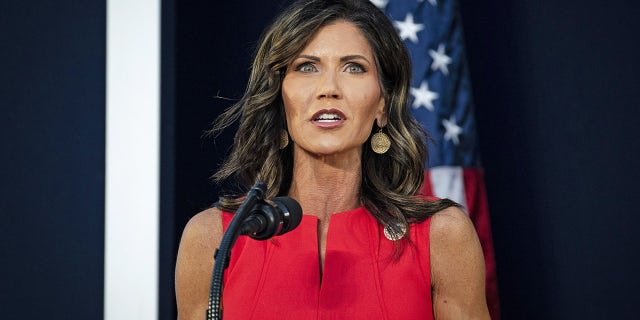In the world of politics, it is not uncommon for public figures to face scrutiny and criticism, and South Dakota Governor Kristi Noem is no exception. Recently, a series of photographs of Noem in a bikini sparked widespread discussion and debate. While some argue that these images are a violation of privacy, others believe they offer a glimpse into a different side of a public figure. In this article, we will delve into the context and implications of these photographs, exploring the various perspectives and the larger discourse surrounding them.
The Origin of the Photos: A Personal Snapshot

The photos in question were reportedly taken during a private vacation that Governor Noem enjoyed with her family. These candid snapshots capture her relaxing and enjoying some downtime, much like any other individual would on a holiday. The images, initially intended for personal memory, somehow found their way into the public domain, raising questions about privacy and the boundaries between a public figure’s personal life and their professional image.
The Double Standard Debate: Politics and Personal Life

The release of these photos has ignited a heated debate about the double standards often applied to female politicians. Critics argue that Noem, as a public figure, should not be exempt from scrutiny, and these photos provide a unique perspective on her authenticity and approachability. On the other hand, supporters emphasize the importance of respecting personal boundaries and the need to differentiate between a politician’s public persona and their private life.
The Impact on Perception
While some may argue that these photos offer a more relatable image of Noem, others express concern about the potential impact on her public image and political career. In a political landscape where visual representation plays a significant role, the circulation of such photos could inadvertently shift the focus away from her policy positions and leadership abilities.
Historical Context: Political Scandals and Media Intrusion
The circulation of these photos also invites a discussion about the historical relationship between politics and the media. From the Watergate scandal to more recent controversies, the media has often played a pivotal role in shaping public opinion and exposing political misdeeds. However, the line between legitimate scrutiny and intrusion into private life is often blurred, leaving room for debate.
The Legal and Ethical Dimensions
The publication of these photos raises important legal and ethical questions. Privacy laws in the United States protect individuals from the unauthorized use of their images, and the circumstances surrounding the release of these photos are currently under scrutiny. The ethical implications are equally complex, as they delve into questions of consent, public interest, and the responsibility of the media in handling sensitive information.
The Role of Social Media: A Double-Edged Sword
In today’s digital age, social media platforms have become powerful tools for both personal expression and political discourse. The rapid spread of these photos across social media platforms has amplified the controversy. While social media can empower individuals to share their stories and connect with others, it also carries the risk of misinformation and invasion of privacy.
The Future of Political Image Management
The incident involving Governor Noem’s photos highlights the evolving nature of political image management. In an era where every move of a public figure is scrutinized and documented, politicians must navigate a delicate balance between transparency and privacy. As the public’s appetite for personal insight grows, politicians are faced with the challenge of maintaining a credible and authentic image without sacrificing their right to a private life.
The Power of Visuals: Shaping Public Perception
Visuals, such as photographs, have long been recognized as powerful tools for shaping public perception. The way a politician is portrayed visually can significantly influence how they are perceived by the public. As such, the strategic use of visuals, whether controlled or spontaneous, has become an integral part of political strategy.
Case Studies: Visual Politics in Action
Throughout history, various politicians have mastered the art of visual politics. For instance, former U.S. President Barack Obama’s use of social media and carefully curated photo opportunities contributed to his relatable and approachable image. Similarly, the iconic images of former British Prime Minister Margaret Thatcher, often depicted in a powerful and authoritative light, played a role in shaping her political legacy.
The Impact on Public Trust: Building and Eroding Confidence

The circulation of Governor Noem’s photos also prompts a discussion about the delicate nature of public trust. While some may argue that these photos humanize Noem and build trust with her constituents, others believe that the invasion of her privacy could potentially erode public confidence in her leadership.
The Role of Authenticity: Connecting with Voters
In modern politics, authenticity is often touted as a key factor in building voter trust. Politicians who are perceived as genuine and relatable tend to fare better in elections. The challenge, however, lies in navigating the fine line between being authentic and providing a platform for personal attacks or intrusions.
The Public’s Appetite for Transparency: Reality vs. Idealism
The public’s demand for transparency in politics is often at odds with the desire for a private life. While voters want to feel connected to their leaders and understand their personal stories, the reality is that constant exposure and scrutiny can have detrimental effects on a politician’s well-being and effectiveness.
Conclusion: A Complex Web of Privacy, Politics, and Perception
The controversy surrounding Governor Kristi Noem’s bikini photos serves as a reminder of the complex relationship between politics, privacy, and public perception. As we navigate the digital age, where personal and political lives are increasingly intertwined, it is crucial to strike a balance that respects individual privacy while also fostering an informed and engaged citizenry. The challenge lies in finding a middle ground where politicians can maintain their credibility and authenticity without sacrificing their right to a private life.
Are these photos a violation of privacy laws?
+The legal implications are complex, as privacy laws vary by jurisdiction. In general, the unauthorized use of an individual’s image can be a violation of privacy rights. However, the specific circumstances and context of the photo’s release would need to be examined to determine any legal violations.
How do these photos impact Governor Noem’s political career?
+The impact is difficult to predict, as it depends on various factors, including public opinion, media coverage, and the Governor’s response. While some may see these photos as a distraction, others could view them as a way to humanize Noem and connect with her constituents.
What role does the media play in this controversy?
+The media has a crucial role in shaping public opinion and holding public figures accountable. However, the responsibility to report accurately and ethically is paramount. In this case, the media’s handling of these photos and the subsequent narrative they create will influence public perception of Governor Noem and the controversy as a whole.